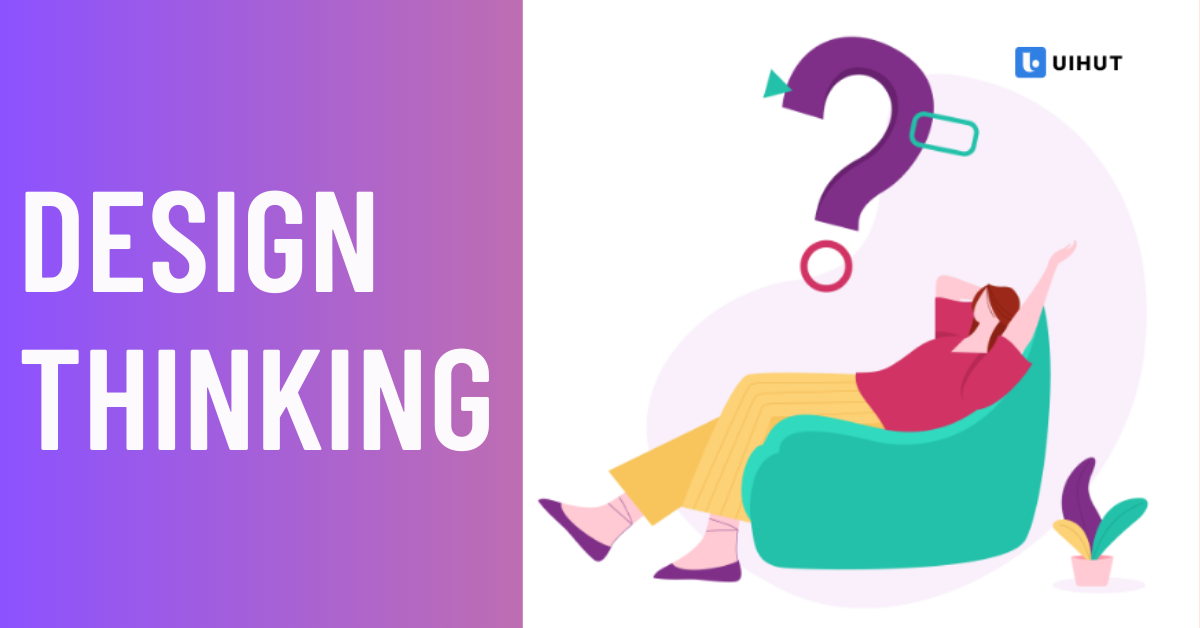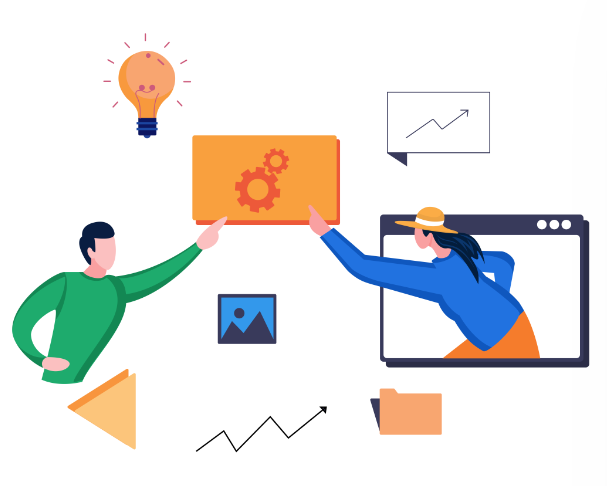What is Design Thinking? A Game-Changing Way to Solve Problems
 Mansurul Haque
Mansurul Haque
Think differently with the design thinking process.
Design thinking is a way of thinking in which problems become opportunities and solutions become possibilities.
This process is for anyone who wants to solve complex problems in a creative and effective way.
It's a methodology that can be applied to various industries from UI/UX design to business strategy and so on.
Whether you're a professional or just starting out, the design thinking process can help you solve problems in a more human-centered and collaborative way.
In this blog, we will explore what is design thinking, its importance, step-by-step process, and key principles.
So, without further ado, let's dive in!
What is design thinking?
Designers try to design something when they want to solve a problem. So, design is solving problems. And a process of solving problems creatively is design thinking.
It is a problem-solving strategy that focuses on understanding customer needs and then applying that knowledge to create innovative solutions.
It's a fantastic mindset and way of working. It’s a guideline for the design team to work on a project. Following this process, designers solve the problems through the lens of the human-centered side. It makes consumers the core of the design to solve any kind of problem.
Importance of Design Thinking
Design thinking streamlines and boosts the creation of products that truly help people and even change their lives.
It is a very important methodology in the business, educational, and social context platforms. It encourages businesses and organizations to consider customers creating their products or services.
By putting the user at the center of the design process, designers can create products, services, and experiences that are intuitive, user-friendly, and effective. It helps to make changes to solutions based on user feedback.
Design thinking is highly useful for solving wicked problems. A wicked problem is one kind of problem that is very complex and difficult. And design thinking promotes creativity and innovation to solve them.
Design thinking helps to focus on the solution rather than getting stuck on the problem. It also inspires teams to explore a wide range of possible solutions, take risks, and learn from failure rather than jumping to conclusions too quickly.
5 Steps of the Design Thinking Process
Let's take a closer look at each of these stages.
1. Empathize
Welcome to the first step of design thinking. When you empathize with someone, you see the world through their eyes.
For designing the best product, you must have a strong understanding of the users' needs, wants, and challenges of the people who will use your product, service, or system.
And this empathy step helps to engage and gain a deeper idea about them. It’s the way of observing people from a psychological perspective.
There are a few simple tips for this step.
Make a list of questions
Who are the people you are designing for?
How do they already feel about similar products on the market?
What are their needs, wants, and desires?
What are their problems?
What difficulties and challenges are they face?
2. Take effective interviews
Ask for their answers and opinions of the questions. This will inspire you who find meaning in your work.
3. Be a good listener
You need to empathize with their situation. So it requires great listening skills to deeply understand what users feel.
4. Collect information
Collect information more specifically that will help to address your users’ actual needs. It will help to know about the kinds of products or services your consumers are interested in.
2. Define
This is for defining the problems identified in the empathize step. It’s the step that turns into insights that you learned in the empathize section.
Tips for this step:
Create user persona
A user persona is a fictional character that represents the end-users of a product or service.
Create journey map
A journey map is a visual representation of the end-user's experience with the problem identified in the Empathize stage.
Create problem statement
After analyzing your experiences, research, data, and observations from interviews, write a problem statement. By writing a statement, you can understand the actual needs that people are trying to fulfill with certain activities.
Ask yourself some questions at this point:
What are the things and insights I can take from empathizing with users?
What is the common user problem that I need to solve?
What patterns did I observe?
Which one am I going to be able to use as information?
Make sure
It defines the problems in a user-centered way.
It addresses what was discovered during the empathize step.
It reflects user needs.
It ensures clarity for the next step of design thinking.
By the end of the define step, you will have a clear user persona, journey map, and problem statement. Now, share this with your team members so that they can try to solve and achieve the goal.
3. Ideate
It’s the most exciting part of the design thinking process. This is where it gets creative. In this step, designers work creatively to find out different ideas from different angles. It can help to come up with innovative out-of-the-box solutions.
Now focus on the problem statement. Depending on the type 0f problem, you’ve to apply different ideas to solve them. With all of the findings from the previous two steps, start to make sense of them. We can divide it into 5 stages,
1. Timeboxing
Set a time limit for each part of the session. Invest equal time in research, design, and feedback. It helps you to focus on your work more effectively.
2. Brainstorming
It refers to thinking outside the box to solve complex problems. Thinking outside the box means thinking differently from a different point of view than the way ordinary people think.
3. Sketching
Sketch out your ideas. It’s a great way to express creativity. It’s a time saver and helps to find out the best idea. It’ll become your biggest source of inspiration.
4. Group discussion
It’s very useful for moving on to a great decision. Make sure every team member can participate and share their ideas and thoughts.
5. Voting
Point out all ideas and allow your team members to vote on the best ideas. Then see which idea got the most votes.
Remember, this step is not to get a perfect idea but rather to come up with many types of ideas. So, after completing these tasks, make a combination of your different ideas. At the end of this step, you can note down possible solutions.
4. Prototype
Now it’s time to turn your ideas into reality. Ask yourself what is your final idea. What is your final solution to this problem?
It’s the step to reflect your ideas, thoughts, and insights that you have learned from previous steps.
The goal is to make something visible that can be tested on real users. Because getting your prototype into the hands of real users will give you great insight if the solution you provided is valid or requires some more work. Based on their feedback, you can change and improve before you spend your time and money building the real thing.
All shapes and visual elements come in prototypes from basic paper/draft to interactive digital mock-ups. This will give you a clear plan. Because whenever you get started on any work practically, you can find a realistic view and feel.
It helps to see your solutions from different views. Your ideas may be accepted, improved, redesigned, or rejected, depending on how users interact with the prototype. Don’t take too much time to start creating solutions.
5. Test
After prototyping comes testing, it’s an experimental step. This is where you test your solutions. It’s time to see how users interact with your product. It provides feedback on the usability and effectiveness of the solution.
So, test your prototype with real users. Invite users to test out and give responses to your prototype. It enables you to see where your prototype works well and where it needs improvement. Any feedback is great to improve your skill.
We always bump into new problems while we have the desire to solve them. This testing step will help you to find out more problems and inspire you to solve them. Your main focus would-be users. You have to point out which combination of solutions you need to apply and figure out how to apply it.
If your test is successful that’s great! If your test is unsuccessful then back to the first step and goes ahead. Repeat the process.
Design thinking is less linear and more repetitive. It’s a long-term process. You’ll need to rethink and redefine what you have done before. And that is the design thinking cycle.
You can find out a great solution because of empathizing with users, defining and matching the ideas that you take from interviews, and creating and testing prototypes with actual users through the design thinking process.
Principles of the design thinking process
Human-Centered
Design thinking places the end-user at the center of the process. It helps to understand their needs, wants, and challenges and create solutions.
Empathetic
Empathy is the core of the design thinking process. Listening, observing, and engaging with users helps to make solutions that are meaningful and relevant to them.
Creative
Design thinking encourages creativity and out-of-the-box thinking to create innovative solutions.
Collaborative
The design thinking process requires collaboration among designers, stakeholders, and end users.
Experimental
Design thinking is experimental. This helps them to test different solutions and make them better than before.
Iterative
This process is iterative. It enables designers to learn from their mistakes and improve their solutions over time.
Conclusion
Whether you want to build a product, launch a startup, or make a positive impact in your community, design thinking can help you create solutions that truly matter.
So why are you waiting?
Apply design thinking to your work today!
Best wishes!
Subscribe to my newsletter
Read articles from Mansurul Haque directly inside your inbox. Subscribe to the newsletter, and don't miss out.
Written by

Mansurul Haque
Mansurul Haque
Founder & CEO at UIHUT




